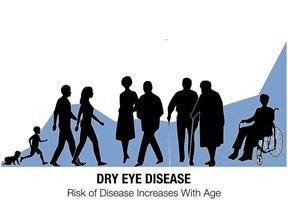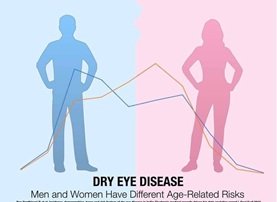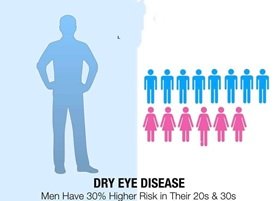Pune faces a crucial issue of dry eyes: Silicon Syndrome!
Our veteran writer on Community Health Issues and Advisor- National Programme for Control of Blindness *Dr. Naresh Purohit, delves into the Dry Eye syndrome in Pune, one of India’s leading centres of IT population.
New Delhi/Pune: Pune faces a crucial issue of dry eyes. The extensive use of computers and electronic devices in the city, along with elevated levels of allergens and pollutio n, contributes to the rising incidence of dry eye cases. Ocular allergies, in particular, impact tear film quality, exacerbating the symptoms of dry eyes. Once a rare concern Dry Eye Disease (DED) cases have more than doubled over the past few years and it is now affecting the city’s population at an increasing rate, especially children and young adults. Pune’s worsening air quality is also adding fuel to the fire, with pollutants and dust further exacerbating symptoms.
n, contributes to the rising incidence of dry eye cases. Ocular allergies, in particular, impact tear film quality, exacerbating the symptoms of dry eyes. Once a rare concern Dry Eye Disease (DED) cases have more than doubled over the past few years and it is now affecting the city’s population at an increasing rate, especially children and young adults. Pune’s worsening air quality is also adding fuel to the fire, with pollutants and dust further exacerbating symptoms.
Rise in allergies due to pollution, along with prolonged screen time, inadequate hydration, and poor sleep, are key contributors for the spike in cases.
Those in the age group of 20-40 are particularly vulnerable, because of their reliance on digital devices for work, studies, and social media.
Dry Eye Disease is common in Asian populations and causes a significant disease burden.
32% of the Indian urban population suffer from Dry Eye Disease and it is expected to increase to 45% by 2030. Since India is an emerging economy with a growing middle-class, increasing urban-migration and a large aging populatio n, the country is on the brink of a dry-eye disease epidemic .
n, the country is on the brink of a dry-eye disease epidemic .
It is estimated that dry eye disease affects over 340 million people worldwide. The rapid increase in smartphone usage and extended screen time has led to a concerning rise of dry eye conditions among the population.
This disease has surfaced as one of the most prevalent ocular conditions in today’s digital era, affecting an estimated 20-50 per cent of adults worldwide. With an increasing trend of prolonged digital device use accompanied by the changing lifestyle and environmental patterns, dry eye is now an emerging condition which requires increased awareness amongst all. Dry eyes refer to a condition that affects the eyes those results from inadequate moisture or lubrication on their surface. This condition can arise from either a reduction in tear production (aqueous deficient type) or from tears evaporating too quickly (evaporative type), in turn leading to inflammation of the eye’s surface.
Dry eyes can greatly impact one’s quality of life by leading to discomfort and visual complaints in individuals. The most frequent symptoms are a burning or stinging sensation, a gritty or sandy feeling in the eyes, increased tearing (because of irritation), heightened sensitivity to light, and blurred vision.
An in-depth eye examination by an ophthalmologist or eye specialist is required for the diagnosis of this condition, while treatment primarily depends on the underlying cause and severity of dry eyes. Treatment alternatives range from artificial tears, eye gels, and ointments to anti-inflammatory eye drops, addressing any underlying lid issues, and in more severe cases, advanced therapies like serum eye drops and bandage contact lenses. Also, severe and complicated cases of dry eye disease may warrant surgical intervention as advised by an eye specialist.
Dry eye disease is a multifactorial condition, where identifying the underlying cause plays a key role in managing and targeting the disease. Therefore, if dry eye symptoms persist, it is crucial to consult a specialist. In an era of digital transformation it is essential to prioritise eye health and proactive care now more than ever for everyone. Common reasons and risk factors associated with dry eyes-

Age: Aging is linked to a decrease in tear production, especially in individuals over 50.
Gender: Women, particularly those who are post-menopausal or undergoing hormonal therapy, face a higher risk because of hormonal shifts that effect tear production.
Environmental factors: Factors like air conditioning, smoke, wind, low humidity, and arid climates can cause increased evaporation of tears and worsen symptoms.
Overuse of digital devices: Extended periods of screen time can reduce the blink rate, resulting in dry eyes.
Medical conditions: Conditions like diabetes, rheumatoid arthritis, and thyroid issues can play a role in contributing to dry eyes. Medications: Drugs such as antihistamines, decongestants, blood pressure medications, and antidepressants can lessen tear production.
Lifestyle Factors: Smoking and the use of contact lenses have been associated with a higher incidence of dry eye disease (DED).
Protection and Safety Tips from Dry Eyes
DO’S:
Frequent conscious blinking when using computer or mobile phones helps in the uniform distribution of tear film.
Constraining time spent on screens and consistently taking breaks to look away from digital devices can help reduce eye strain.
Adjusting your surroundings by utilising humidifiers in arid conditions and setting air conditioning temperatures at 23 degrees celsius or higher is advisable.
Staying well hydrated supports the maintenance of a healthy tear film.
When outside, wearing sunglasses and protective eyewear helps shield your eyes from wind, dust, and UV rays, which can lead to dry eyes.
Including foods or supplements that are high in omega-3 fatty acids (such as fish, walnuts, and flaxseeds) can enhance tear quality.
DONT’s:
Avoid direct air from fans, ACs or heaters. Avoid sleeping with eye make up on as it may worsen symptoms of dry eyes. Refrain from overuse of contact lens.
__________________________________________________
*Dr. Narresh Purohit-MD, DNB, DIH, MHA, MRCP(UK), is an Epidemiologist,  and Advisor-National Communicable Disease Control Program of Govt. of India, Madhya Pradesh and several state Health organizations. He’s the Principle Investigator – Association of Studies In Behavioural Science), Dr. Purohit is also Advisor-National Mental Health Program .
and Advisor-National Communicable Disease Control Program of Govt. of India, Madhya Pradesh and several state Health organizations. He’s the Principle Investigator – Association of Studies In Behavioural Science), Dr. Purohit is also Advisor-National Mental Health Program .

Comments are closed.